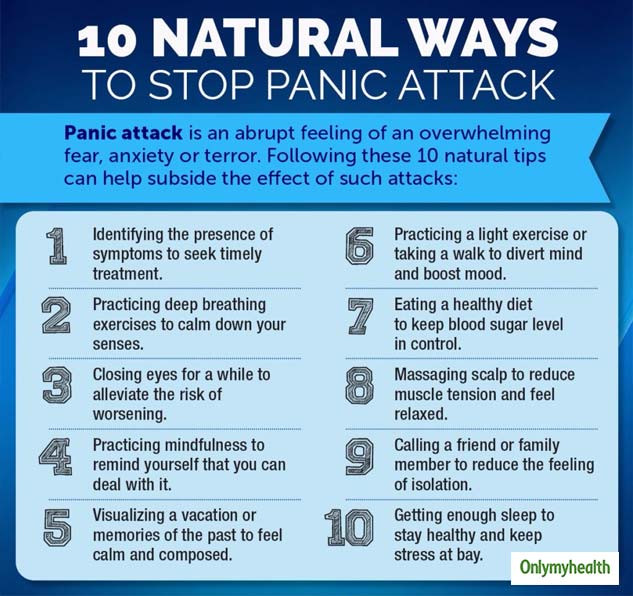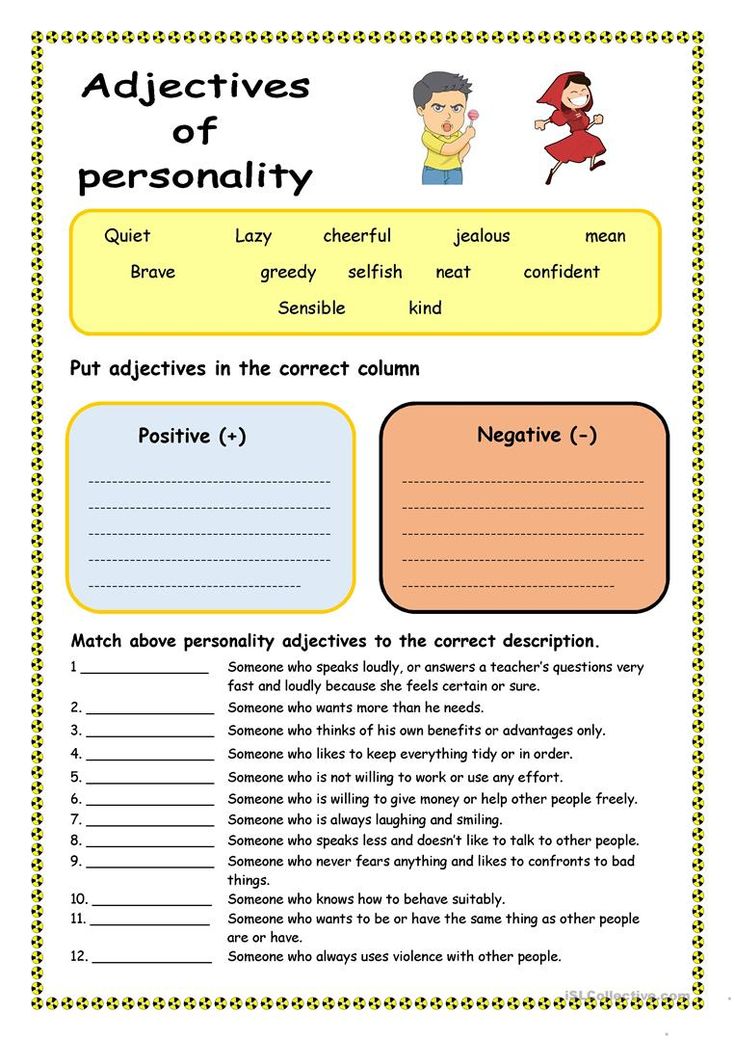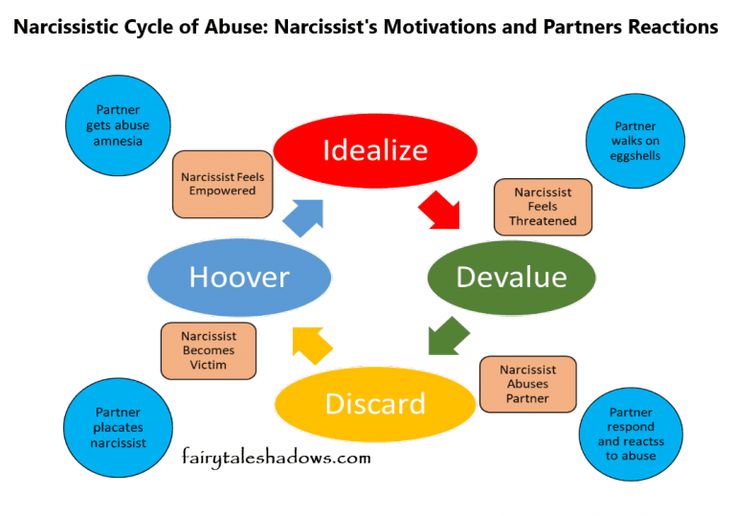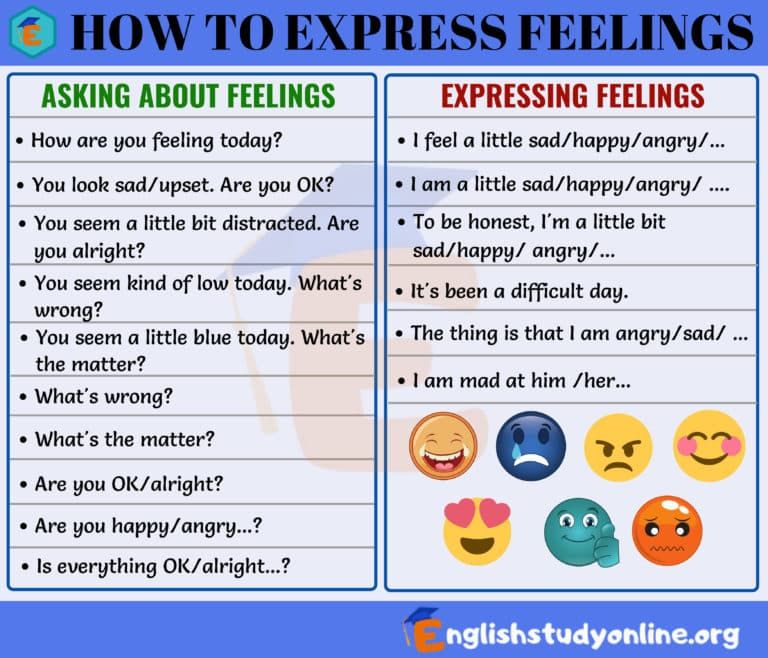What to do while having a panic attack
How to deal with panic attacks
A panic attack is a feeling of sudden and intense anxiety.
Panic attacks can also have physical symptoms, including shaking, feeling disorientated, nausea, rapid, irregular heartbeats, dry mouth, breathlessness, sweating and dizziness.
The symptoms of a panic attack are not dangerous, but can be very frightening.
They can make you feel as though you are having a heart attack, or that you are going to collapse or even die.
Most panic attacks last somewhere from five minutes to half an hour.
How to handle a panic attack
Professor Paul Salkovskis, Professor of Clinical Psychology and Applied Science at the University of Bath, says it's important not to let your fear of panic attacks control you.
"Panic attacks always pass and the symptoms are not a sign of anything harmful happening," he says. "Tell yourself that the symptoms you're experiencing are caused by anxiety."
He says don't look for distractions. "Ride out the attack. Try to keep doing things. If possible, it's important to try to remain in the situation until the anxiety has subsided."
"Confront your fear. If you don't run away from it, you're giving yourself a chance to discover that nothing's going to happen."
As the anxiety begins to pass, start to focus on your surroundings and continue to do what you were doing before.
"If you’re having a short, sudden panic attack, it can be helpful to have someone with you, reassuring you that it will pass and the symptoms are nothing to worry about," says Professor Salkovskis.
Breathing exercise for panic attacks
If you’re breathing quickly during a panic attack, doing a breathing exercise can ease your other symptoms. Try this:
- breathe in as slowly, deeply and gently as you can, through your nose
- breathe out slowly, deeply and gently through your mouth
- some people find it helpful to count steadily from one to five on each in-breath and each out-breath
- close your eyes and focus on your breathing
You should start to feel better in a few minutes.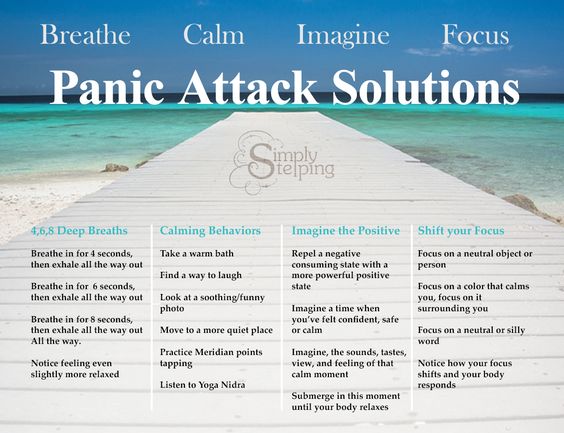 You may feel tired afterwards.
You may feel tired afterwards.
Visit the No Panic website for another breathing exercise to calm panic.
Ways to prevent panic attacks
"You need to try to work out what particular stress you might be under that could make your symptoms worse," says Professor Salkovskis. "It's important not to restrict your movements and daily activities."
- Doing breathing exercises every day will help to prevent panic attacks and relieve them when they are happening
- Regular exercise, especially aerobic exercise, will help you to manage stress levels, release tension, improve your mood and boost confidence
- Eat regular meals to stabilise your blood sugar levels
- Avoid caffeine, alcohol and smoking – these can make panic attacks worse. Panic support groups have useful advice about how you can effectively manage your attacks. Knowing that other people are experiencing the same feelings can be reassuring. Your GP can put you in touch with groups in your area
- Cognitive behavioural therapy (CBT) can identify and change the negative thought patterns that are feeding your panic attacks
Is it panic disorder?
If you feel constantly stressed and anxious, particularly about when your next panic attack may be, you may have panic disorder.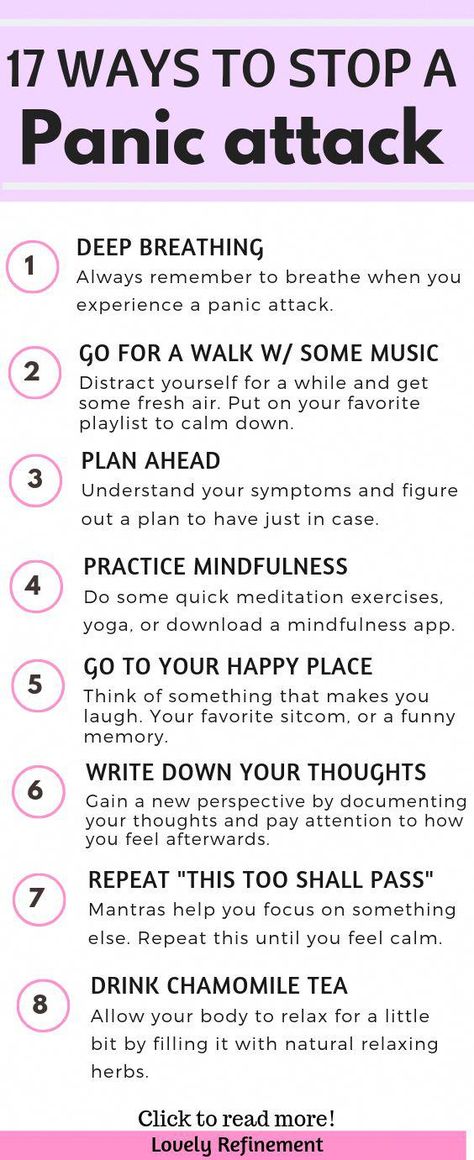
People with panic disorder may avoid situations that might cause a panic attack. They may also fear and avoid public spaces (agoraphobia).
"There's no quick fix, but if your attacks are happening time after time, seek medical help," says Professor Salkovskis.
Read more about panic attacks, including personal stories, at See Me Scotland.
What They Are, How to Stop, and More
Panic attacks can be scary and may hit you quickly. Here are 12 strategies you can use to try to stop or manage panic attacks. Some may help you in the moment, while others can help in the longer term.
1. Seek
counselingCognitive-behavioral therapy (CBT) and other types of counseling can often help people who have panic attacks and who have panic disorders. CBT aims to help you change the way you see challenging or frightening situations and to help you find new ways to approach these challenges as they arise.
You can find CBT for individuals or groups, online or face-to-face, and the length of treatment can also vary. In exposure-based CBT, your therapist will expose you to something that can trigger a panic attack and help you work your way through it.
In exposure-based CBT, your therapist will expose you to something that can trigger a panic attack and help you work your way through it.
As well as changing behavior, there is some evidence that CBT might affect structures in your brain that are responsible for panic symptoms.
In 2018, some researchers found evidence that people who attended four weekly sessions of exposure-based CBT experienced changes in the neural pathways involved in panic symptoms. However, this was an early study, and more research is needed.
In 2018, 37 people in Korea attended a mindfulness-based program once a week for 4 weeks, to see if brief treatment would help reduce symptoms of panic disorder. One aspect of the treatment was to focus on their heart rate, as some people experience cardiovascular symptoms during a panic attack.
The findings suggested that the participants could better manage their symptoms using their own thought processes after the treatment. However, this was a small study, and there was no control group.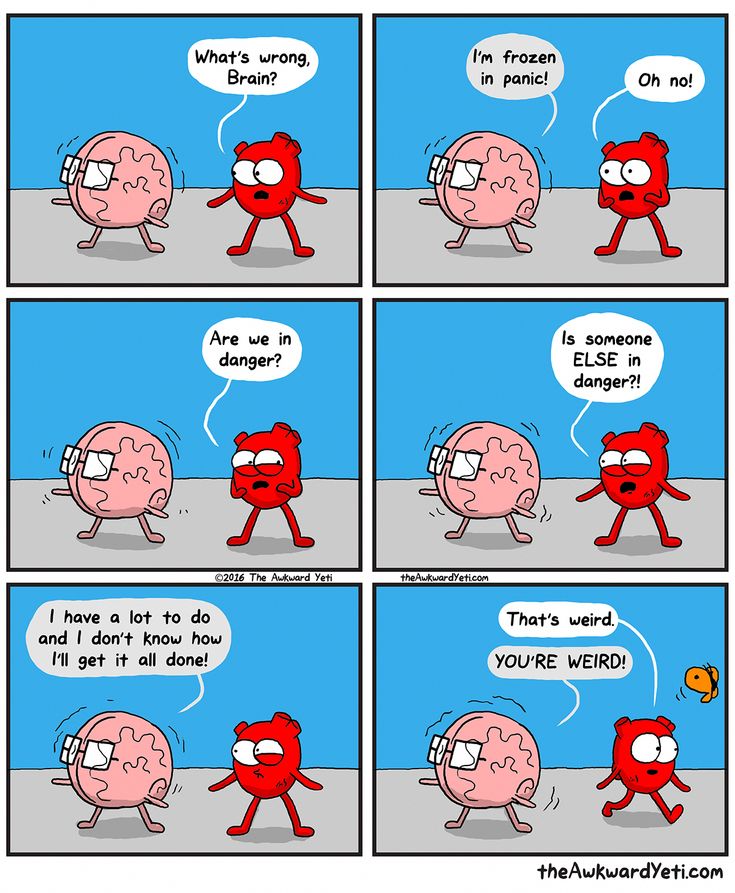 More research is needed to find out how effective short-term therapy can be.
More research is needed to find out how effective short-term therapy can be.
2. Take medications
Benzodiazepines, such as alprazolam (Xanax), can help treat the symptoms of panic when they occur.
However, they won’t help treat an underlying anxiety disorder and can quickly lead to dependence. For this reason, doctors only recommend them for short-term use during a crisis.
Because benzodiazepines are a prescription medication, you’ll likely need a panic disorder diagnosis to have the medication on hand.
In some cases, a doctor may prescribe anti-depressants for long-term use. Examples include:
- selective serotonin reuptake inhibitors (SSRIs), such as escitalopram (Lexapro) or fluoxetine (Prozac)
- serotonin-norepinephrine reuptake inhibitors (SNRIs), such as duloxetine (Cymbalta)
- anti-anxiety drugs, for instance, azapirone (Buspirone)
Some anti-seizure medications, such as pregabalin or clonazepam, can also help treat anxiety.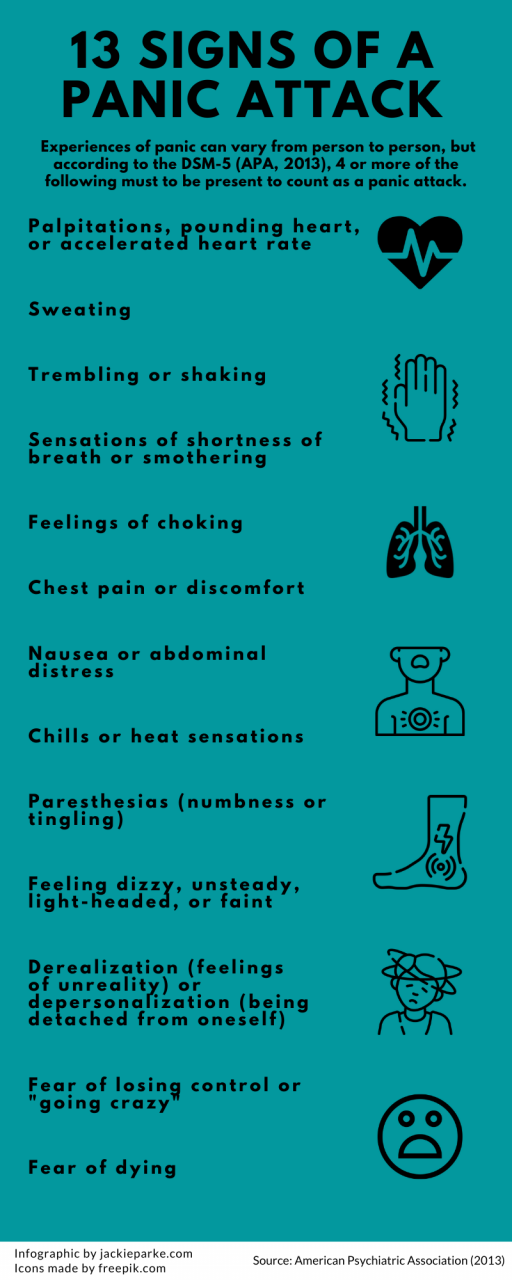
Which drugs can treat anxiety disorder?
3. Use deep breathing
While hyperventilating is a symptom of panic attacks that can increase fear, deep breathing can reduce symptoms of panic during an attack.
In one study, published in 2017, 40 people joined either a therapy group that involved deep or diaphragmatic breathing or a control group. After 20 intensive training sessions, those who practiced deep breathing saw improvements in their attention levels and emotional well-being.
Blood tests also showed lower cortisol levels in this group, suggesting lower levels of stress. The participants did not have panic disorder, but the strategies could help people who have panic attacks.
Another group of scientists found that slow breathing could have similar effects. They suggested it could also improve feelings of relaxation, comfort, and alertness and reduce symptoms of arousal anxiety, depression, anger, and confusion.
If you’re able to control your breathing, you’re less likely to experience the hyperventilating that can make other symptoms — and the panic attack itself — worse.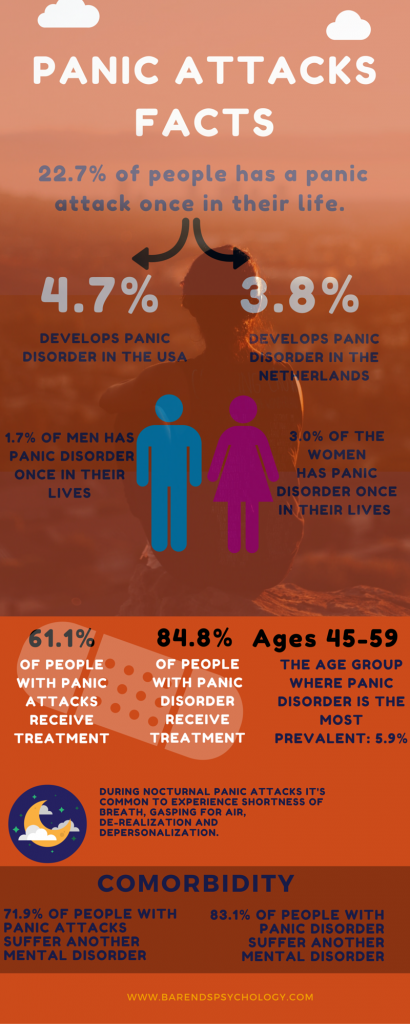
Focus on taking a deep breath in through your nose, feeling the air slowly fill your chest and belly. Then slowly exhale through your mouth and feel the air leave your body. Breathe in through your nose for a count of four, hold for a second, and then breathe out through your nose for a count of four:
What is diaphragmatic breathing and how do you do it?
4. Recognize that you’re having a panic attack
By recognizing that you’re having a panic attack instead of a heart attack, you can remind yourself that this is temporary, it will pass, and that you’re OK.
Take away the fear that you may be dying or that impending doom is looming, both symptoms of panic attacks. This can allow you to focus on other techniques to reduce your symptoms.
It is not always possible to avoid triggers for a panic attack, but if you know what triggers it, this can help you understand that it is a panic attack and not something else.
5. Close your eyes
Some panic attacks come from triggers that overwhelm you. If you’re in a fast-paced environment with a lot of stimuli, this can feed your panic attack.
If you’re in a fast-paced environment with a lot of stimuli, this can feed your panic attack.
To reduce the stimuli, close your eyes during your panic attack. This can block out any extra stimuli and make it easier to focus on your breathing.
6. Practice mindfulness
Mindfulness can help ground you in the reality of what’s around you. Since panic attacks can cause a feeling of detachment or separation from reality, this can combat your panic attack as it’s approaching or actually happening.
Mindfulness involves:
- focusing your attention on the present
- recognizing the emotional state you’re in
- meditating to reduce stress and help you relax
Focus on the physical sensations you are familiar with, like digging your feet into the ground or feeling the texture of your jeans on your hands. These specific sensations ground you firmly in reality and give you something objective to focus on.
Experts say that mindfulness strategies, such as meditation, can help manage anxiety symptoms, although it’s not clear they can treat an underlying anxiety disorder.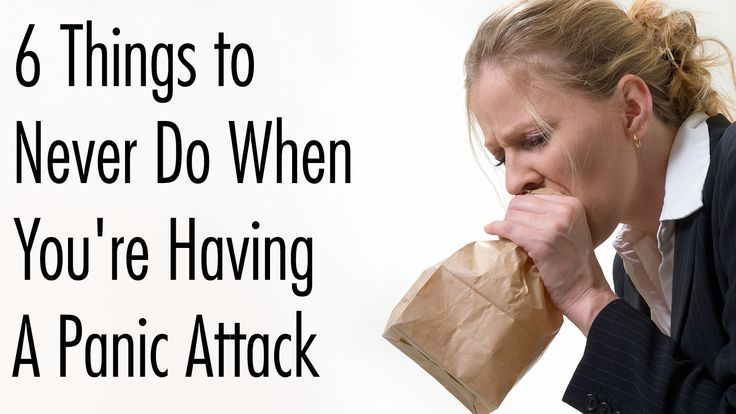
American Family Physician recommended mindfulness as a strategy for dealing with panic and anxiety in 2015, saying it can be as helpful for reducing stress as CBT and other behavioral therapies.
Some research has suggested that mindfulness-based cognitive therapy could help people with anxiety disorders who are receiving medical treatment but haven’t found drug treatment helpful.
Online meditation options
Read our review of the best online meditation options to help find the right fit for you.
7. Find a focus object
Some people find it helpful to find something to focus all their attention on during a panic attack. Pick one object in clear sight and consciously note everything about it possible.
For example, you may notice how the hand on the clock jerks when it ticks, and that it’s slightly lopsided. Describe the patterns, color, shapes, and size of the object to yourself. Focus all your energy on this object, and your panic symptoms may subside.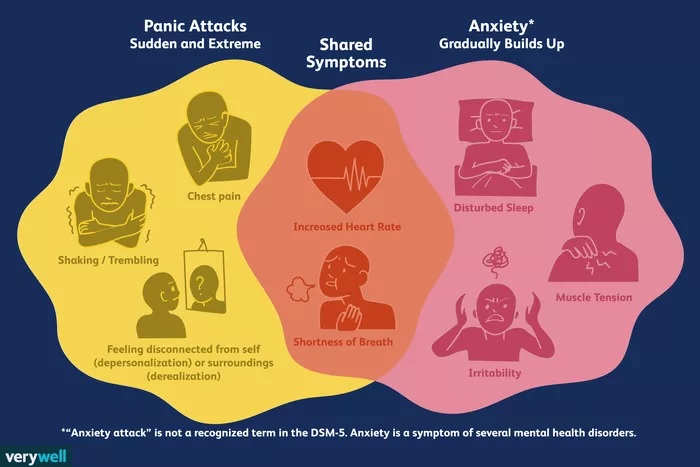
8. Use muscle relaxation techniques
Muscle tension is a symptom of anxiety, and muscle relaxation techniques can help reduce tension and promote relaxation during an attack. Progressive muscle relaxation aims to release tension in one group of muscles at a time to relax the whole body.
Much like deep breathing, muscle relaxation techniques can help stop your panic attack in its tracks by controlling your body’s response as much as possible.
If you attend muscle relaxation therapy, your therapist might take you through the following steps:
- First, you may learn how to tense the muscles before releasing the tension.
- Then, you will learn how to relax the muscles without tensing them first.
- You may also learn how to relax specific sets of muscles, for example, in the shoulders, for practical use in everyday situations.
- Finally, you may learn how to practice rapid relaxation, when you can identify any areas of tension and release it as needed.

To start relaxing your muscles at home, consciously relax one muscle at a time, starting with something simple like the fingers in your hand, and move your way up through your body.
Muscle relaxation techniques will be most effective when you’ve practiced them beforehand.
9. Picture your happy place
Guided imagery techniques can help reduce stress and anxiety. Research suggests that both spending time in nature and visualizing nature can help treat and manage anxiety.
What’s the most relaxing place in the world that you can think of? A sunny beach with gently rolling waves? A cabin in the mountains?
Picture yourself there and try to focus on the details as much as possible. Imagine digging your toes into the warm sand, or smelling the sharp scent of pine trees.
This place should be quiet, calm, and relaxing — no streets of New York or Hong Kong, no matter how much you love the cities in real life.
Here, learn about five visualization techniques that can help you meditate.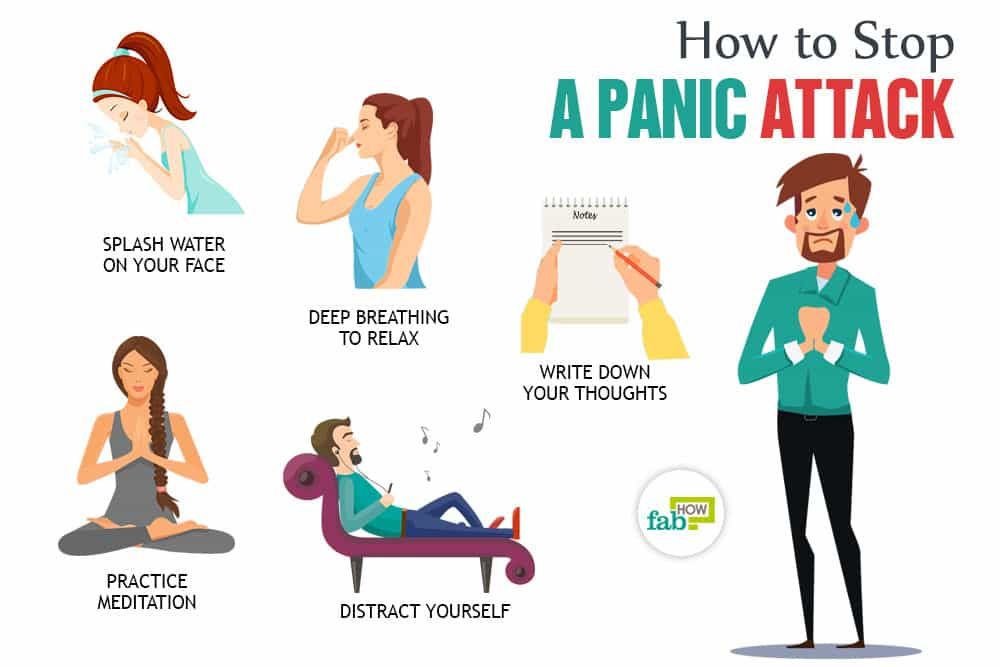
10. Engage in light exercise
Research shows that regular exercise can not only keep the body healthy but boost mental well-being, too.
Experts have found that exercising at 60 to 90 percent of your maximum heart rate for 20 minutes three times per week can help reduce anxiety.
If you are not used to exercising, talk with your doctor before starting. There is some evidence that starting aerobic exercise anew can trigger additional anxiety in people with an anxiety disorder. Building up gradually can help your body adjust and avoid breathing problems. Aerobic exercise includes activities such as running on a treadmill.
If you feel stressed or you’re hyperventilating or struggling to breathe, stop and take a rest or choose a more moderate option, such as walking, swimming, or yoga.
11. Keep lavender on hand
Lavender is a traditional remedy that many people use to reduce stress and help them relax.
Research suggests it has a calming effect but doesn’t lead to dependence or cause withdrawal symptoms.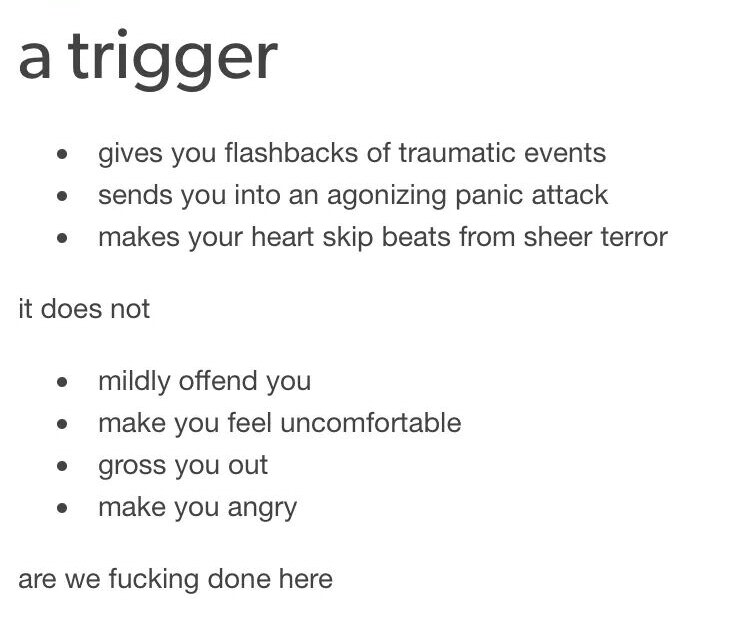 Using products that contain diluted lavender oil may help reduce or manage symptoms of anxiety.
Using products that contain diluted lavender oil may help reduce or manage symptoms of anxiety.
However, the Food and Drug Administration (FDA) does not regulate essential oils, and strengths and ingredients vary widely.
If you use lavender essential oil, make sure you:
- get your oil from a reputable source, such as a pharmacy
- follow the instructions for use
- avoid applying concentrated oil directly to the skin
- avoid using lavender with benzodiazepines because the combination can cause intense drowsiness
While research suggests there are health benefits, the FDA doesn’t monitor or regulate the purity or quality of essential oils. It’s important to talk with a healthcare professional before you begin using essential oils and be sure to research the quality of a brand’s products. Always do a patch test before trying a new essential oil.
Which essential oil is right for you?
12. Repeat a mantra internally
Repeating a mantra internally can be relaxing and reassuring, and it can give you something to grasp onto during a panic attack.
Whether it’s simply “This too shall pass,” or a mantra that speaks to you personally, repeat it on loop in your head until you feel the panic attack start to subside.
Panic attacks are sudden, intense surges of fear, panic, or anxiety. They are overwhelming, and they have physical as well as emotional symptoms.
If you have a panic attack, you might find you have difficulty breathing, you sweat profusely and tremble, and you may feel your heart pounding.
Some people will also experience chest pain and a feeling of detachment from reality or themselves during a panic attack, so they may think they’re having a heart attack. Others have reported feeling like they are having a stroke.
Causes
Panic attacks can happen for various reasons, and sometimes they happen for no apparent reason.
You’re more likely to experience them if you:
- have panic disorder
- have another anxiety disorder
- use certain substances or have a substance use disorder
- use certain medications
- have a medical condition, such as an overactive thyroid
- have a condition that involves psychosis
A panic attack often happens when you’re exposed to a trigger, but triggers vary widely between people.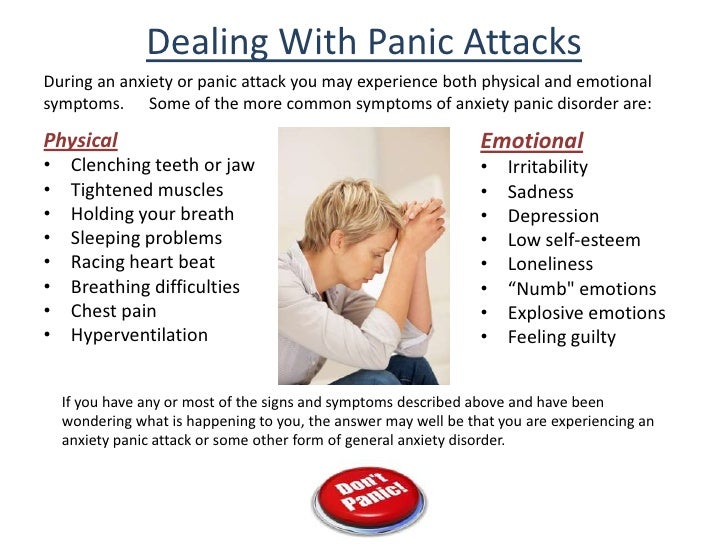 In some cases, there may be no clear trigger.
In some cases, there may be no clear trigger.
However, some people find that the following can trigger an attack:
- social events
- public speaking
- conflict
- situations that remind you of past or current stress in your life
Here, learn more about the causes and triggers of panic attacks.
Symptoms
The Diagnostic and Statistical Manual of Mental Health Disorders, Fifth Edition (DSM-5) defines a panic attack as “an abrupt surge of intense fear or discomfort.”
They tend to start without warning, and symptoms reach a peak within minutes.
If you have a panic attack, here are some of the symptoms you might experience:
- a pounding heart, palpitations, or rapid heart rate
- sweating
- shaking or trembling
- difficulty breathing or feeling as if you are choking or being smothered
- chest pain or discomfort
- nausea or stomach upset
- feeling dizzy, light-headed, or faint
- feeling unsteady
- chills or feeling hot
- numbness or tingling
- feelings as if things are unreal
- feeling detached from yourself.

- fear of losing control or “going crazy”
- fear of dying
It is not always possible to prevent a panic attack, but the following tips may help:
- do breathing exercises every day
- get regular exercise
- follow a diet that is low in added sugar and eat regularly to avoid glucose spikes
- avoid caffeine, smoking, and alcohol, as they may make anxiety worse
- seek counseling and other professional help
- ask your doctor about local support groups
Avoiding specific triggers may help prevent a panic attack, but this may not always be possible or appropriate. Some experts encourage people to “ride out” the attack and continue doing things, if possible.
However, if a situation is likely to cause severe distress, consider waiting until you’ve worked with a professional to develop skills and strategies to help you cope.
If you have concerns about panic attacks, consider talking with a doctor, especially if:
- You have one or more panic attacks and continue to worry about panic attacks for a month or longer.
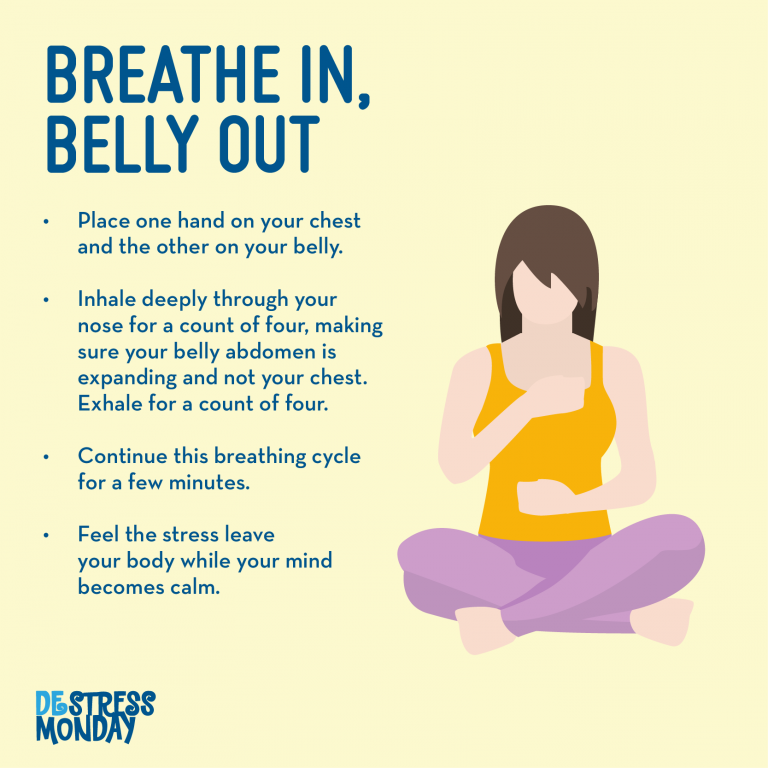
- You find yourself changing your behavior after an attack.
- Your concerns or feelings of fear or anxiety are affecting your work, studies, or daily life.
Many people experience panic attacks, in which they suddenly feel anxious and not in control of a situation, possibly without knowing why.
You may feel breathless or as if you are having a heart attack, and it can be very frightening.
Panic attacks can occur unexpectedly and have a significant impact on your daily life, but there are ways to manage them. Treatment is also available for panic and anxiety disorders, which may be an underlying condition.
If you have concerns about panic attacks, speak with your doctor. They can help you work out a suitable strategy to manage symptoms and reduce the impact. This may involve medications, such as antidepressants, alongside counseling.
Read this article in Spanish.
What to do with a panic attack?
. Psychologist's adviceUpdated October 27, 2022, 13:24
Shutterstock
Fear, fright and anxiety are evolutionarily necessary for a person to survive.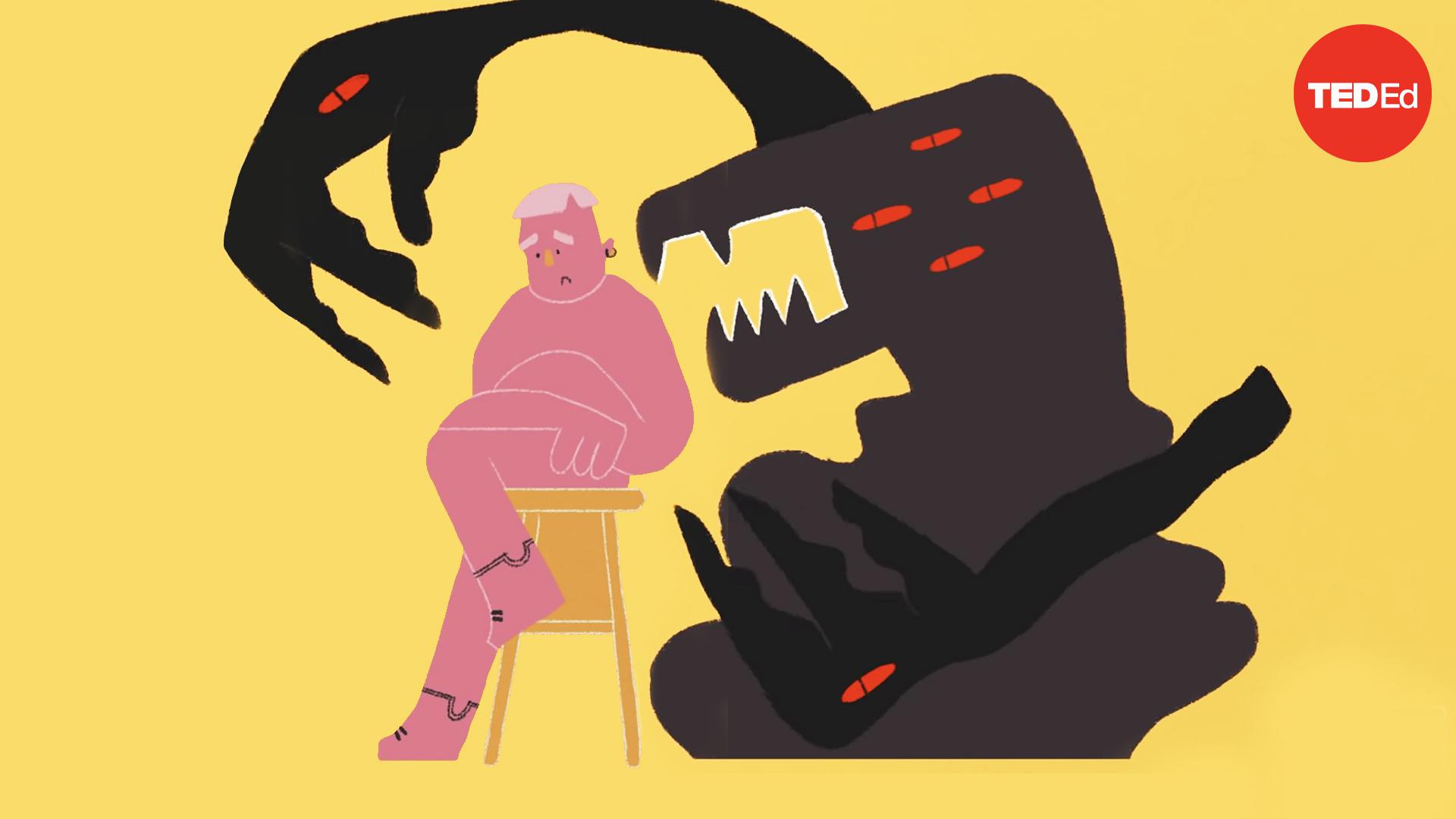 However, sometimes high anxiety can provoke panic disorder, in which there are repeated bouts of severe anxiety - panic. If attacks occur frequently, the quality of life is rapidly reduced, so it is important to learn how to cope with them.
However, sometimes high anxiety can provoke panic disorder, in which there are repeated bouts of severe anxiety - panic. If attacks occur frequently, the quality of life is rapidly reduced, so it is important to learn how to cope with them.
RBC Life, together with experts, understands how you can help yourself and your loved ones when faced with this destructive state.
Contents
- What is it
- Symptoms
- Causes
- What to do
- How to help the person
What is a panic attack
Pexels
A panic attack is a sudden attack of anxiety, an acute fright, which is accompanied by a deterioration in well-being, unpleasant sensations in the body and autonomic disorders - rapid breathing, tachycardia, sweating, weakness, decreased pressure, tremor or a feeling of suffocation, lasting, as a rule, from 5 to 30 minutes.
Usually a person is afraid of such a condition and perceives the symptoms as a manifestation of a heart attack or stroke.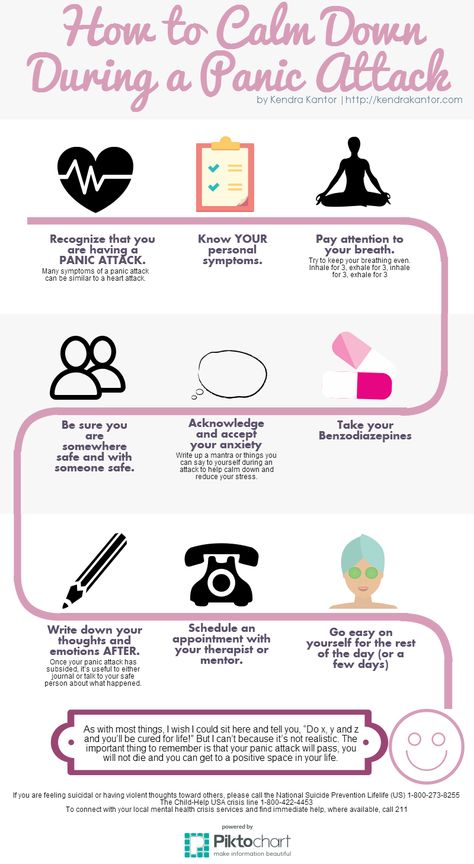 In this case, an uncontrollable fear of death may appear.
In this case, an uncontrollable fear of death may appear.
“A panic attack is not a diagnosable disease, but a symptom that may indicate that a person has an anxiety disorder, emotional exhaustion, or chronic stress. At its core, this is not a disease, it is a misinterpretation of the condition. And this condition arises due to chronic emotional overstrain,” explains Alexey Krasikov, founder of the School of Emotional Intelligence and Psychotherapy, consultant psychologist in the field of anxiety disorders and the development of stress resistance.
Psychologist Andrei Chernyshev tells how important it is to distinguish a panic attack from an attack of fear. In the first case, the episode will be limited in time: the attack usually lasts 15–20 minutes. This is due to the release of hormones - adrenaline, norepinephrine, cortisol.
Panic attacks are the result of destructive thoughts that a person constantly scrolls in his head. Concentrating on these scripts can cause impotence, headaches, or nausea.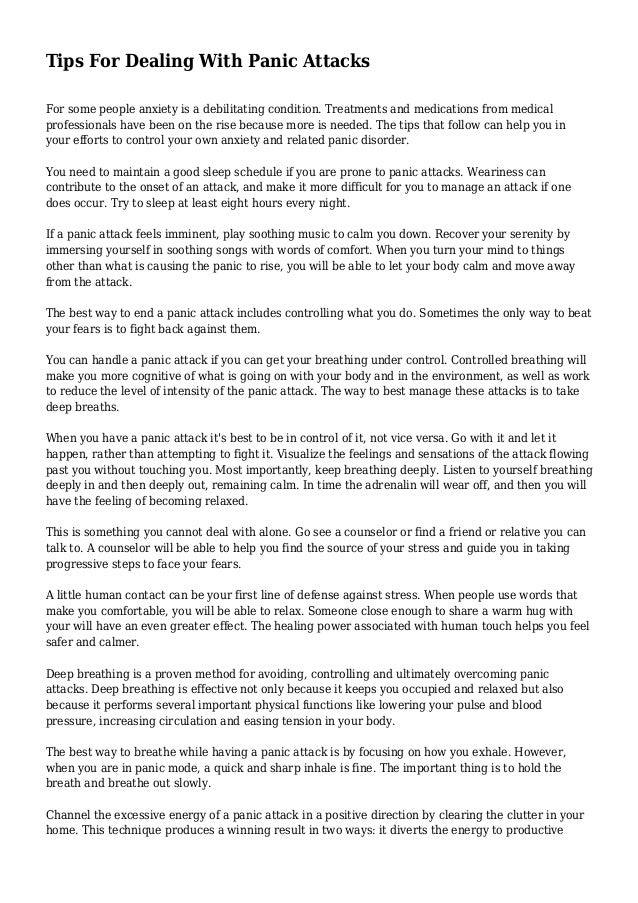 In addition, panic attacks can cause immediate harm to health, as attacks occur suddenly, sometimes while driving or in a dream, the expert notes.
In addition, panic attacks can cause immediate harm to health, as attacks occur suddenly, sometimes while driving or in a dream, the expert notes.
Panic attacks are a manifestation of phobias or anxiety-depressive disorders, says Sergey Pozdnyakov, head of the Center for Psychological Correction of Diseases at Medsi Group. Previously, panic attacks were diagnosed mainly in women aged 20–45, but today they appear in children of seven–eight years, as well as in people aged 70+. The increase in the number of disorders is influenced by the accelerating rhythm of life and the increase in the information flow, which constantly affects the nervous system. According to WHO, 30% of the world's population has experienced a panic attack at least once in their lives.
Panic attack symptoms
Shutterstock
As Aleksey Krasikov notes, a panic attack is often confused with a heart attack. But there are a number of nuances. For example, pain in angina pectoris is described as a “burning sensation in the chest”, and during a vegetative crisis, they may not be at all. Patients report feelings of anxiety, a feeling that the heart is not working “correctly”, but do not experience symptoms of angina pectoris. A panic attack is an emotional, not a physiological, disorder, so sedatives help to correct the situation. Drugs that stop cardiac symptoms are useless in this case, the psychologist adds.
Patients report feelings of anxiety, a feeling that the heart is not working “correctly”, but do not experience symptoms of angina pectoris. A panic attack is an emotional, not a physiological, disorder, so sedatives help to correct the situation. Drugs that stop cardiac symptoms are useless in this case, the psychologist adds.
Anastasia AfanasyevaPsychiatrist, psychotherapist, clinical director of the psychological platform Alter
“Panic attacks manifest through physical and mental symptoms. You can understand that this is a panic attack if there are at least two physical signs and at least one of the mental ones.
Physical symptoms of a panic attack may include:
- shortness of breath, feeling short of breath;
- rapid pulse (up to 130-170 beats per minute) and strong heartbeat;
- pain or discomfort in the region of the heart;
- dizziness, lightness in head;
- loss of stability or pre-syncope;
- flushes of heat or coldness in the body, chills;
- nausea;
- excessive sweating;
- tremors in the muscles;
- numbness or tingling in the extremities.
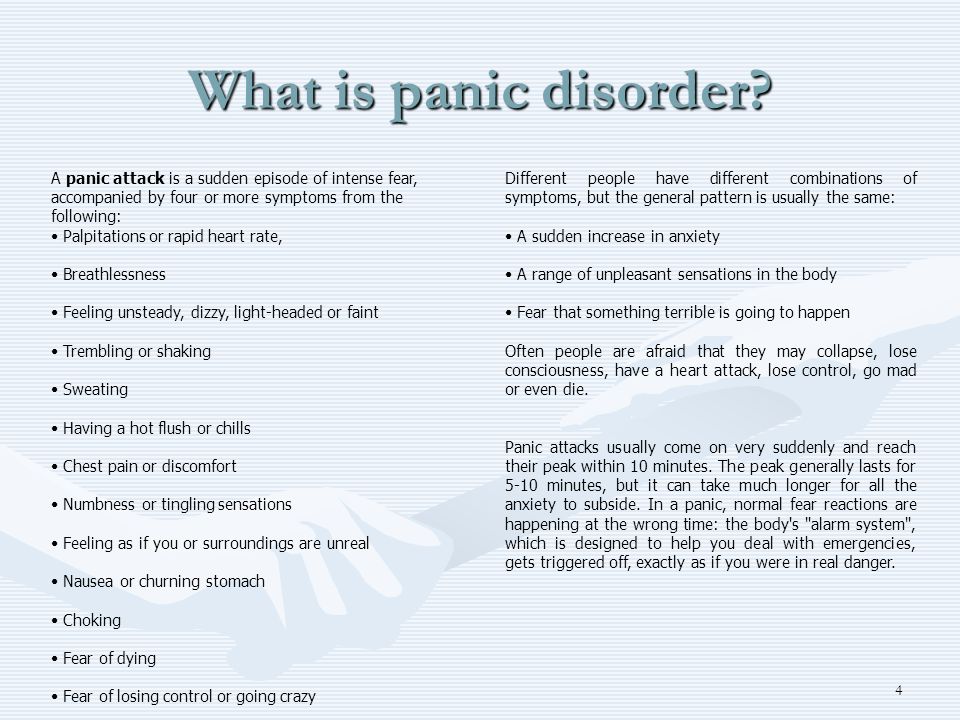
The following manifestations are considered to be mental signs of a panic attack:
- fear of going crazy or losing control over oneself;
- fear of death;
- depersonalization and / or derealization - loss of connection with reality, a violation of an adequate perception of oneself and / or the surrounding space, a feeling that you are “not yourself” or the world around has become different, ghostly, unreal.
Causes of panic attacks
Shutterstock
Aleksey Krasikov notes that the main cause of a panic attack is fear. A person experiences unusual experiences and misinterprets them - believes in a catastrophe or feels the proximity of death. In this case, the balance between the sympathetic and parasympathetic nervous systems shifts towards the first. In fact, a panic attack is an instinct of a person who scared himself.
A person does not have a predisposition to panic attacks, a study by the US National Institute of Mental Health has proven [1].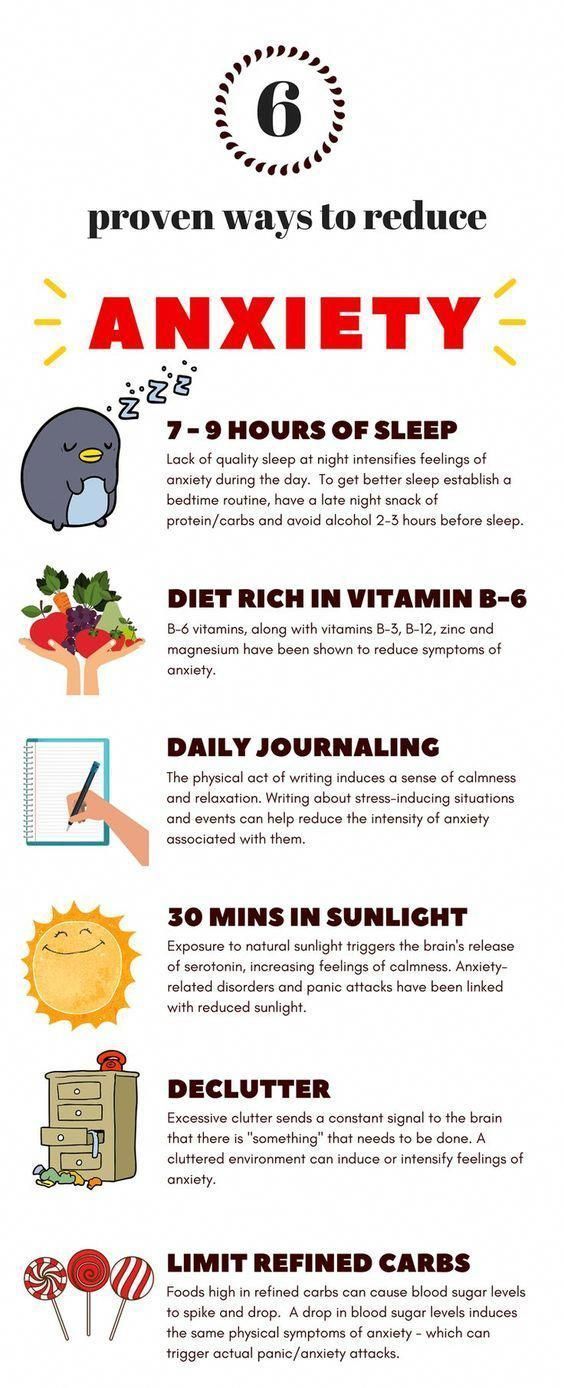 Their main cause is a general anxiety condition caused by various circumstances.
Their main cause is a general anxiety condition caused by various circumstances.
Among the risk factors for the development of panic attacks [2]:
- stress associated with illness or death of loved ones;
- traumatic event in the past: violence, accident, emergency;
- changes in life: change of residence, job, divorce, birth of a child;
- unresolved childhood injuries;
- smoking and excessive caffeine intake;
- phobias, depression, obsessive-compulsive disorders.
Anastasia Afanasyeva:
“A panic attack is an excessive reaction of the body to a stimulus that our brain regards as a danger to life. That is why one of the characteristic signs of a panic attack is the fear of dying or not getting help.
How does a panic attack occur?
The brain receives a signal that it labels as a threat to our existence, and begins to secrete norepinephrine, which, in turn, stimulates the adrenal glands to produce stress hormones - adrenaline and cortisol.
When adrenaline enters the bloodstream, it triggers automatic survival responses: fight, run or freeze.
In order for the body to perform these actions, adrenaline acts on various body systems, making them work faster and more intensively. For example, in order to strike or run away, our muscles must actively contract, for this they need energy, which is taken from oxygen and glucose in the blood. Therefore, the lungs begin to breathe faster, and the heart begins to beat harder to pump blood faster.
These are the physical signs we see in a panic attack.”
How to deal with a panic attack
Unsplash
If you suspect that you have an anxiety disorder, psychologist Alexei Krasikov advises you to see a doctor. It is necessary to conduct an examination of the body: get advice from a cardiologist and a neurologist, evaluate clinical blood indices, hormone levels, and do an ultrasound scan. If health problems are identified at this stage, the patient will be referred to a specialized specialist for the selection of therapy.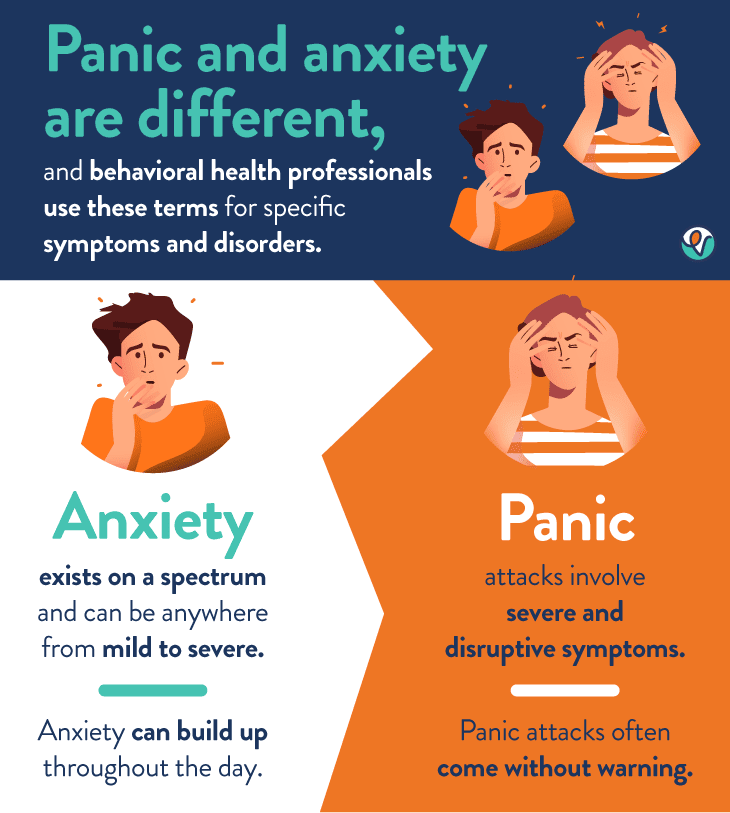
If no diseases are detected, psychotherapists and psychologists are involved. They will teach you how to respond appropriately to life's circumstances.
Such therapy includes:
- informing about the causes and mechanism of panic;
- formation of the skill of correct interpretation of the state;
- exclusion of avoidant behavior, leveling of fears;
- study of the anamnesis and causes that provoked the crisis;
- Reconstruction of the system of relations, training in rational response.
According to the psychologist, sedatives are required only at the beginning of therapy or in especially severe cases. Duration of admission depends on the specific case and usually takes from several months to a year.
Panic Attack Self Help
Pexels
Here are some tips from psychologist Aleksey Krasikov on how to deal with an attack on your own:
- Realize that it was just an adrenaline rush during the fright.
 This in itself is completely safe.
This in itself is completely safe. - Remember the main rule: "The more I resist, the harder it will be for me." No need to do anything, no matter how strange it may sound: no running, no fussing. Breathe deeply and evenly.
- Try to let the stress and fear go through you.
- During a panic attack, a person concentrates on his body, closes and thus only stimulates panic. Therefore, it is important to switch to something else. You can divert attention to the pain sensation, for example, pinching your earlobe or other part of the body.
- You can resort to breathing into a paper or plastic bag, through a folded handkerchief or scarf, to reduce the level of oxygen in the blood, which helps to calm down.
- Call someone. Talking on the phone can be a very good distraction from the current state.
Andrey Chernyshev says that the fear that causes panic is accompanied by tunnel thinking. In this case, a person cannot be distracted from experiences.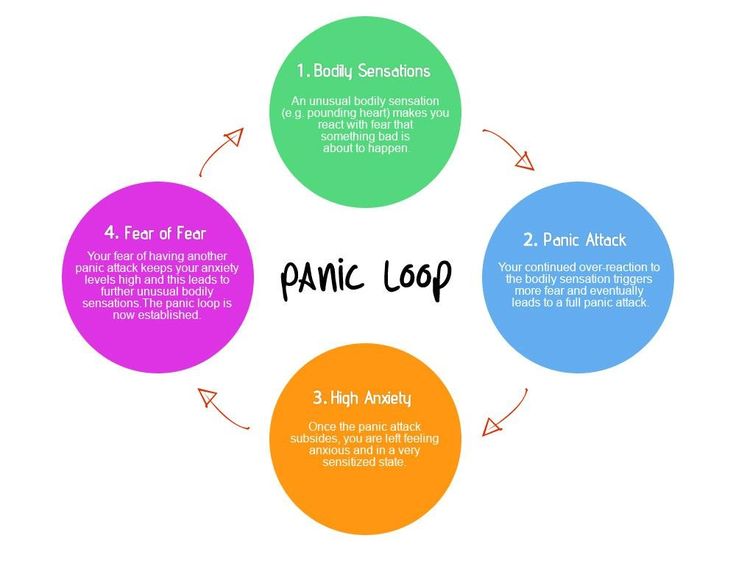 It's like blinders that are put on horses to keep them looking straight ahead. A person who has succumbed to panic also perceives information. Therefore, in order to stop an attack, it is important to stop and think in time. It is difficult to do this at the moment of panic, but you can think over the tactics of behavior while in a calm state. The psychologist advises to remember people, events or things that give a sense of security. Or set a reminder on your phone and write anything that will help you feel better.
It's like blinders that are put on horses to keep them looking straight ahead. A person who has succumbed to panic also perceives information. Therefore, in order to stop an attack, it is important to stop and think in time. It is difficult to do this at the moment of panic, but you can think over the tactics of behavior while in a calm state. The psychologist advises to remember people, events or things that give a sense of security. Or set a reminder on your phone and write anything that will help you feel better.
Anastasia Afanasyeva:
“It is paradoxical as it may seem, the key rule for coping with a panic attack is not to react to it in any way. In fact, this is biologically justified: when adrenaline rages in the body and causes all those signs of a panic attack that we talked about, a person perceives these symptoms as a sign that something terrible will happen to him now, and begins to worry even more. So we find ourselves in a vicious circle: adrenaline is released again in the body, and all sensations are intensified.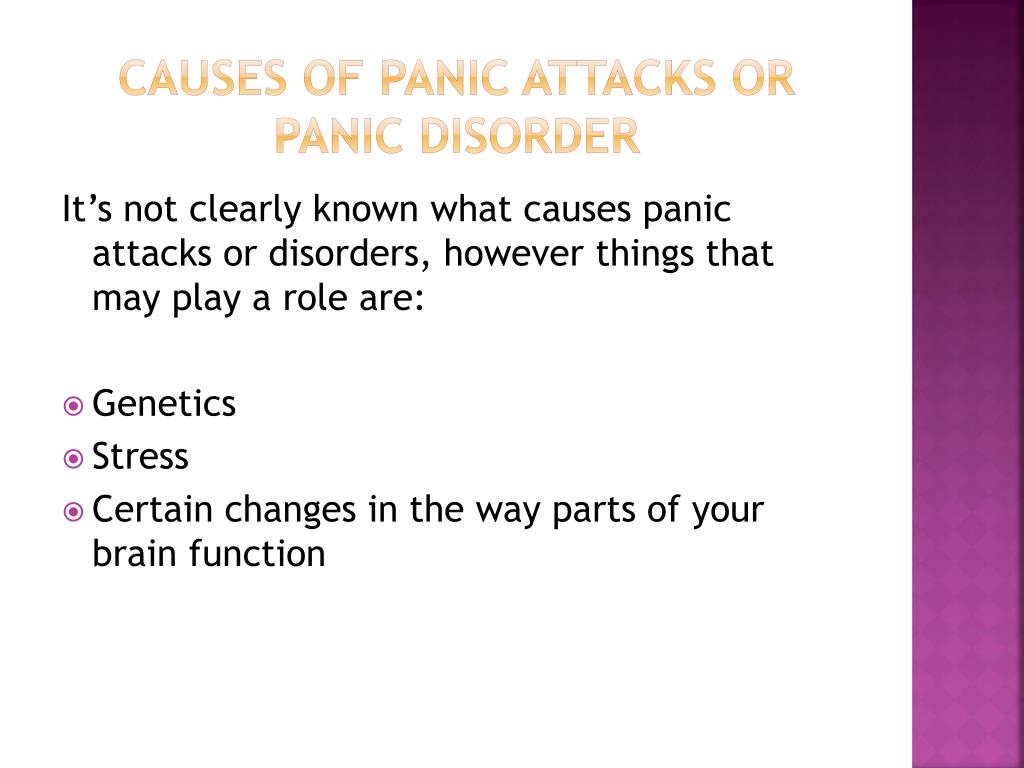
If we realize that there is no direct threat to our life and that our brain is just "playing it safe", then the panic will go away in just a few minutes.
Therefore, at the moment of great stress, it is important to remember that this is only an adrenaline rush and nothing threatens us physically. This reaction will quickly end if we stop feeding it. Try to imagine that this feeling of anxiety is like a wave that rolls in and gradually fades.
It also helps at times like this to just keep doing what you were doing, like walking down the street.
Breathing practices are very helpful. They activate the parasympathetic system, which creates a sense of security.
- You can focus on your breathing by consciously observing the inhalation and exhalation, feeling how cold air passes through the respiratory tract and comes back already warm.
- Another good exercise is "4-7-8": four counts - slow breath in, seven counts - breath holding and eight counts - long calm exhalation.

Physical activity is also important, especially outdoors. Walk, run, jump, dance - movement helps to work off excess adrenaline and complete the cycle of stress response.
Finally, look to others for support. If there is someone around to talk to, or better yet, hug, don't hesitate to ask for it.
What you definitely shouldn't do is eat up panic or fight it with alcohol or other substances. This may provide temporary relief, but in the end it will only aggravate your condition and lead to other unpleasant consequences. The best way to deal with anxiety is to allow yourself to experience those emotions and reactions rather than trying to dull them.
If you have panic attacks on a regular basis and you feel that you cannot cope with them on your own, do not hesitate, contact a psychotherapist.
How to help a person with a panic attack
Pexels
Anastasia Afanasyeva:
“If we see that someone has a panic attack, the main thing we can do is help the person survive it.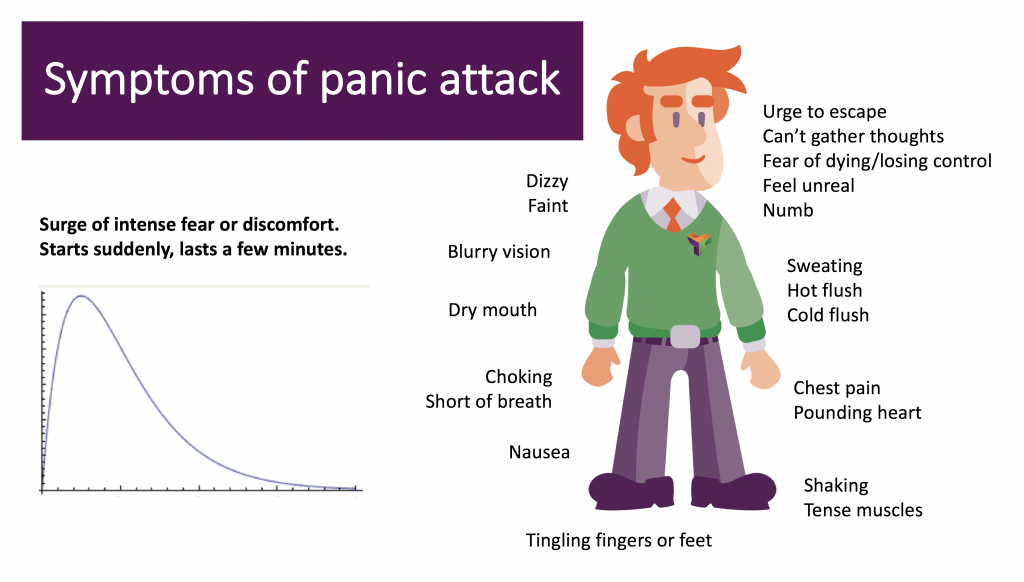 Explain what is happening to him. You can tell him: “I know that you are scared right now and that you may feel that something bad can happen to you. But it's just a very strong anxiety. Your body has released an incredible amount of stress hormones like adrenaline, and because of that, you have a lot of sensations in your body. I am close to you. It will soon pass. Let's just stay together, breathe."
Explain what is happening to him. You can tell him: “I know that you are scared right now and that you may feel that something bad can happen to you. But it's just a very strong anxiety. Your body has released an incredible amount of stress hormones like adrenaline, and because of that, you have a lot of sensations in your body. I am close to you. It will soon pass. Let's just stay together, breathe."
Panic attacks usually do not last more than 10-15 minutes. Therefore, it is important to be with this person, sit next to him, you can give him water, offer to breathe together and wait until the panic passes. This is the most efficient way."
Share
Article content
Authors
Tags
Irina Vorobieva
Panic attacks (episodic paroxysmal anxiety) - attacks of severe anxiety (panic) or fear (most often - fear of death, less often - fear of loss of consciousness, loss of control, helplessness or fear of "going crazy"), accompanied by a rapid heartbeat and a feeling of "suffocation", "lack of air".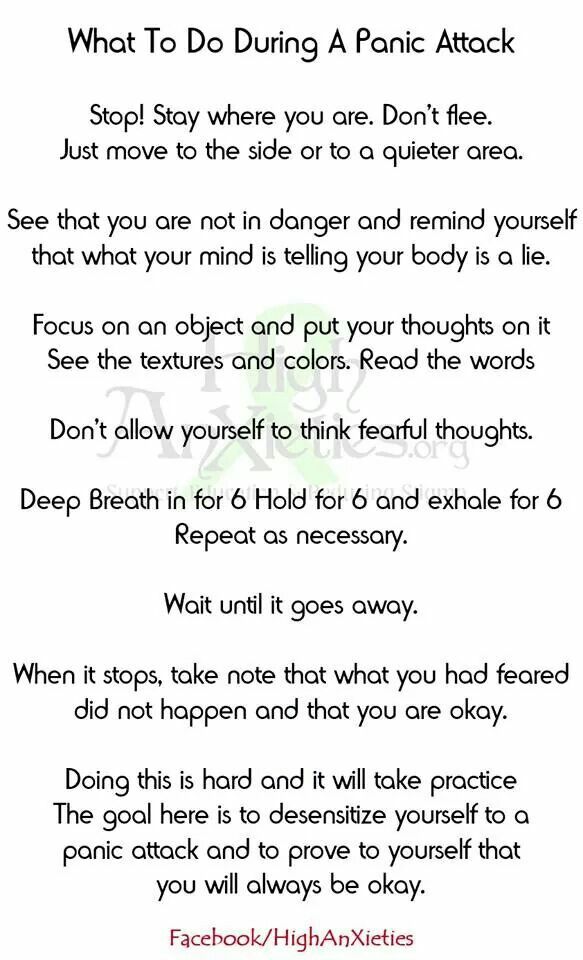 Sometimes there are additional symptoms such as increased blood pressure, a feeling of "internal trembling", trembling in the limbs, a feeling of "hot flashes" of heat or cold, numbness of the extremities, increased sweating, a feeling of "unstability" or dizziness, nausea, derealization or depersonalization, etc.
Sometimes there are additional symptoms such as increased blood pressure, a feeling of "internal trembling", trembling in the limbs, a feeling of "hot flashes" of heat or cold, numbness of the extremities, increased sweating, a feeling of "unstability" or dizziness, nausea, derealization or depersonalization, etc.
Panic attacks last on average 5 to 30 minutes. However, sometimes they can last several hours, and in rare cases - up to several days.
I must say that even 30 years ago this disease was extremely rare. But now the incidence of panic attacks is increasing exponentially every year! Especially in big cities. Alas, panic attacks are considered a “disease of megacities”. And they suffer, most often, people with increased anxiety and the so-called perfectionists.
Earlier, in Soviet medicine, this disorder was called " sympathoadrenal crises ". This name, more than the modern one, reflected the essence of the processes occurring in the body during panic attacks.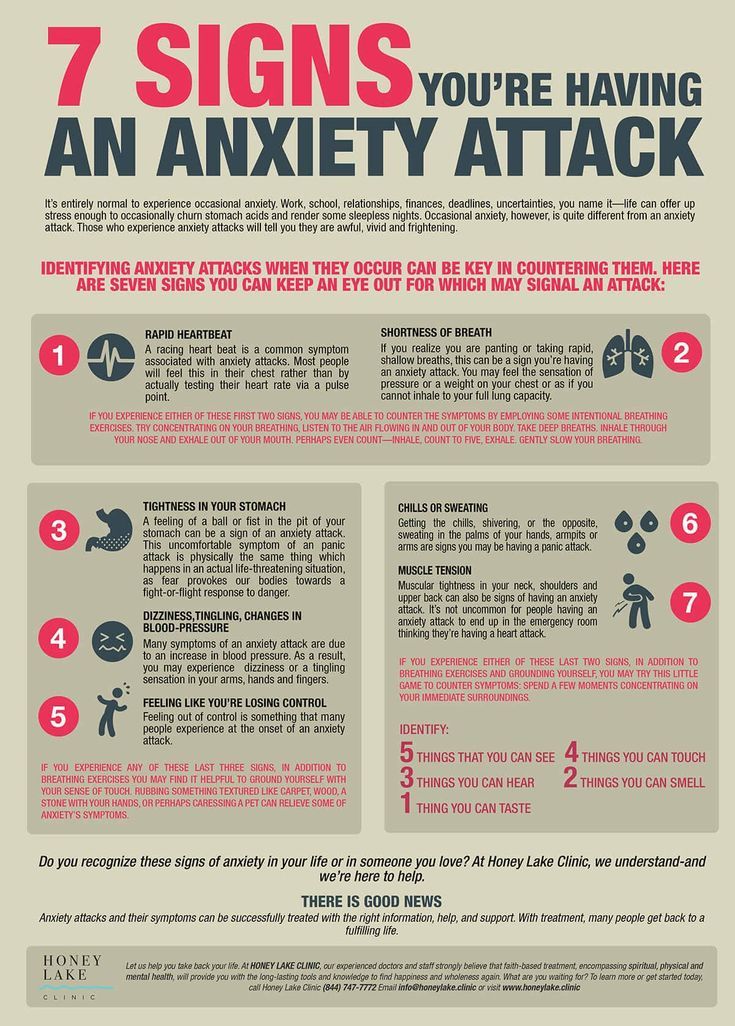 Nevertheless, I will not bother readers with a description of biochemical processes and a list of the hormones and neurotransmitters involved in these reactions. Knowing this practically does not affect the fact of the occurrence of seizures. Because biochemical processes are just an "intermediate link" in the chain of cause and effect relationships occurrence of panic attacks . What then is the "primary link", so to speak, the root cause?
Nevertheless, I will not bother readers with a description of biochemical processes and a list of the hormones and neurotransmitters involved in these reactions. Knowing this practically does not affect the fact of the occurrence of seizures. Because biochemical processes are just an "intermediate link" in the chain of cause and effect relationships occurrence of panic attacks . What then is the "primary link", so to speak, the root cause?
Panic attacks occur suddenly, and, as it often seems, without any external causes or under the influence of minor unpleasant factors (an ordinary quarrel in the family, another trouble at work, overcrowding and stuffiness in a subway or train car, a long “traffic jam” on the road, etc.). etc.). In fact, panic attacks always occur against the background of an already long-term depression (most common), or after repeated or severe stress (more precisely, distress). Don't be surprised by this, because it is quite difficult for an ordinary person, not a specialist, to diagnose depression.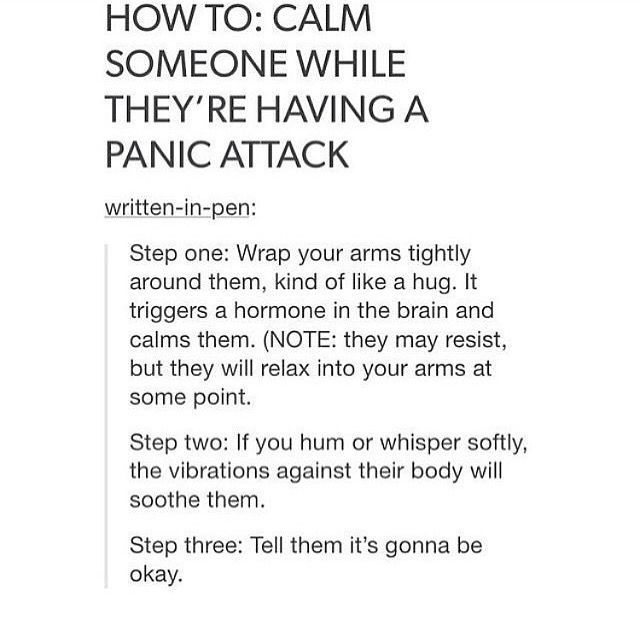 Especially, at himself. Moreover, its mild or atypical forms. Especially if it lasts a year or several years (and for some people - since childhood!). In this case, they may not even remember how they felt without depression. In this variant, the body functions “with the last of its strength”, works “at the limit of its capabilities”; and some minor unpleasant event can be the “last straw” for him! Figuratively speaking, a panic attack is “hysteria of the body”, its “desperate cry: “I can’t do this anymore !!!”
Especially, at himself. Moreover, its mild or atypical forms. Especially if it lasts a year or several years (and for some people - since childhood!). In this case, they may not even remember how they felt without depression. In this variant, the body functions “with the last of its strength”, works “at the limit of its capabilities”; and some minor unpleasant event can be the “last straw” for him! Figuratively speaking, a panic attack is “hysteria of the body”, its “desperate cry: “I can’t do this anymore !!!”
Well, in the question "Who is to blame?" figured it out. Now let's move on to the equally important question "What to do?" The fact that no one in the world has yet died from panic attacks is little consolation for those suffering from this excruciating disorder. To say that panic attacks are an unpleasant state is an understatement! These are unbearable sensations, and in the most severe cases, a real feeling of approaching death, which a person is sometimes forced to experience daily! And most importantly, he does not understand what is happening to him, and how to stop it!
Panic attacks sharply reduce the quality of a person's life, subordinating her entire expectation of the next attack. And, accordingly, they affect social activity, sometimes making a person completely incapacitated.
And, accordingly, they affect social activity, sometimes making a person completely incapacitated.
When panic attacks first appeared in the clinical practice of physicians, they were treated empirically with various sedatives and tranquilizers . However, after their cancellation, the seizures reappeared, and with prolonged use of these drugs, tolerance (insensitivity) inevitably and rather quickly set in. Therefore, in order to stop panic attacks, it was necessary to constantly increase doses or resort to more “strong” tranquilizers. But everywhere there is a limit: the number of tranquilizers is not unlimited, especially their doses. It was necessary to remember another very important aspect: long-term use of these drugs causes dependence on them. And after the abolition of tranquilizers, the symptoms of mental and physical withdrawal joined the renewed panic attacks, which further worsened the patient's condition.
Then the treatment tactics were somewhat changed: antidepressants were added to "light" or small doses of "medium power" tranquilizers. And it was a "breakthrough" in the treatment of panic attacks! Because antidepressants do not just "relieve" the symptoms, but they affect the foundation on which these attacks are based - depression itself! Of course, in modern medicine there are a huge number of antidepressants, and the effectiveness of their effect on panic attacks is very different. But an experienced psychotherapist or psychiatrist can quite accurately select a drug that is suitable for a particular person. It is important to note that antidepressants have a cumulative effect, so their therapeutic effect does not appear immediately after the appointment, but after a certain time (on average, after a month). And, here, the full duration of treatment with antidepressants is, at best, from 6 to 12 months, and sometimes up to several years.
And it was a "breakthrough" in the treatment of panic attacks! Because antidepressants do not just "relieve" the symptoms, but they affect the foundation on which these attacks are based - depression itself! Of course, in modern medicine there are a huge number of antidepressants, and the effectiveness of their effect on panic attacks is very different. But an experienced psychotherapist or psychiatrist can quite accurately select a drug that is suitable for a particular person. It is important to note that antidepressants have a cumulative effect, so their therapeutic effect does not appear immediately after the appointment, but after a certain time (on average, after a month). And, here, the full duration of treatment with antidepressants is, at best, from 6 to 12 months, and sometimes up to several years.
At the same time, there are cases of especially severe courses of panic attacks, when the appointment of even "powerful" antidepressants for a sufficiently long time does not bring the desired effect, i.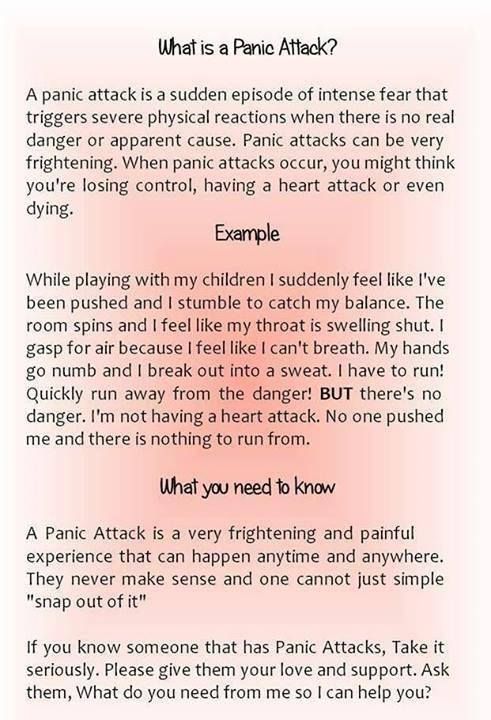 e. panic attacks do not stop completely, but only become less pronounced or occur less frequently. In this version, a person, anyway, does not feel healthy and constantly lives in fear of the next attack. In this case, doctors are forced to launch "heavy artillery" - to add NEUROLEPTICS to the treatment, which patients have to take for quite a long time. Antipsychotics have a large number of unpleasant side effects, which is why many patients refuse them.
e. panic attacks do not stop completely, but only become less pronounced or occur less frequently. In this version, a person, anyway, does not feel healthy and constantly lives in fear of the next attack. In this case, doctors are forced to launch "heavy artillery" - to add NEUROLEPTICS to the treatment, which patients have to take for quite a long time. Antipsychotics have a large number of unpleasant side effects, which is why many patients refuse them.
However, there is another way to treat panic attacks. He is not a drug! That is, there is a REAL METHOD OF COMPLETE CURING FROM PANIC ATTACKS, ABSOLUTELY WITHOUT RESORTING TO ANY KIND OF MEDICINES !!! This method is PSYCHOTHERAPEUTIC.
In the modern world there are a lot of different types and directions of psychotherapy. But, it must be said bluntly that with panic attacks, most of them are not effective without medical support.
However, the method that I use in my psychotherapeutic work is unique. It often allows you to completely eliminate panic attacks in 1 session! One or two more sessions are required to eliminate the FEAR of the appearance of seizures (or their expectation).